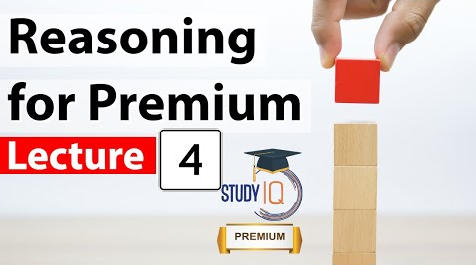Table of Contents
- P#Q – All P is Q.
- P@Q – Some P is Q.
- P©Q – No P is Q.
- P$Q – Some P is not Q.
Statements:
- A # X © M @ D
Conclusions:
- D @ X
- A $ X
- D @ M
- D © X
- None of these
- P#Q – All P is Q.
- P@Q – Some P is Q.
- P©Q – No P is Q.
- P$Q – Some P is not Q.
Statements:
- A @ M @ C @ D
Conclusions:
- D @ A
- M @ D
- C @ M
- A © C
- None of these
Six people A, B, C, D, E and F are living in six floor building, ground floor is numbered 1, floor above it is numbered 2 and so on. Who is living on the Ground floor?
- Statement I: There is only one floor between C and B. A is living in even number floor. E is not living in even number floor. B is living in even number floor. B is not living in top
- Statement II: D is living in odd number floor. There are two floors between D and A. E is living just above C.
Seven persons A, B, U, V, W, X, and Z are sitting in a straight line equidistant from each other (but not necessarily in the same order). Some of them are facing south while some are facing north.
- A faces north. Only two people sit to the right of
- B sits third to the left of A. Only one person sits between B and X. X sits to the immediate right of W. Only one person sits between W and Z
- Both the immediate neighbors of B face the same direction. U sits third to the left of X. V faces the same direction as W. Both Z and U face the opposite direction. Which of the following option we cannot determine from the above information.
- Direction of Z.
- Direction of B.
- Number of person facing north.
- More than one of the above information.
Which of the following symbols should replace the sign (@) and (%) respectively in the given expression in order to make the expression L ≥ U and R > J definitely true?
L ≥ K ≥ P = N = J @ U ≤ A % R
(a) ≤, =
(b) ≤, ≤
(c) >, ≤
(d) =, <
(e) ≥, <
Which of the following will be definitely true if the given expression T≥U≥M=N<J=P<Q≤R is definitely true?
- T< J
- U>M
- R>N
- R ≥ M
- T<P
INPUT—2538 5628 8516 7524 6325 2645
- STEP I– 2358 2568 1568 2457 2356 2456
- STEP II– 1568 2356 2358 2456 2457 2568
- STEP III– 56 35 35 45 45 56
- STEP IV– 11 8 8 9 9 11
Input: 3846 9213 8273 7341 5218 3285 6925 4758
Input: 3846 9213 8273 7341 5218 3285 6925 4758
What will the addition of the numbers which is second, forth, sixth and eight from the left end in step IV?
- 32
- 23
- 38
- 40
- None of these
Input: 3846 9213 8273 7341 5218 3285 6925 4758
Which of the following would be the difference of the numbers which is 2nd from left end in step I and forth from right end in Step II?
(a) 1138
(b) 1287
(c) 1139
(d) 2125
(e) None of these
Input: 3846 9213 8273 7341 5218 3285 6925 4758
Which of the following element will be 3rd to the left of 7th from the left end in step III?
- 34
- 37
- 25
- 35
- None of these
- Seven friends A, B, C, D, E, F and G scored different marks viz. 15 , 20 , 30 , 40 , 45 and 50. Only two of them scored the same. They like different subjects viz. English, Maths, Geography and Hindi. They belong to different cities viz. Lucknow, Pune, Chennai and Kolkata. Not more than 2 persons like same subject or belong to same city.
- The one who scored 30 does not like Maths. The one who scored least belongs to Pune. E scored highest among all and likes English and belongs to Pune. A belongs to either Lucknow or Pune. The one who likes Geography does not belong to Lucknow. D scored between A and B. Only one person who belongs to Lucknow likes Maths. F scored 45 and belongs to same city as A. Two of them, who likes Geography scored 15 and 20. G scored more than A. B and D like same subject. The one who likes Hindi belongs to Kolkata and is the only one who likes this subject and belongs to this city. G belongs to Chennai and scored same as C.
Maths/Reasoning | Free PDF






















 WhatsApp
WhatsApp